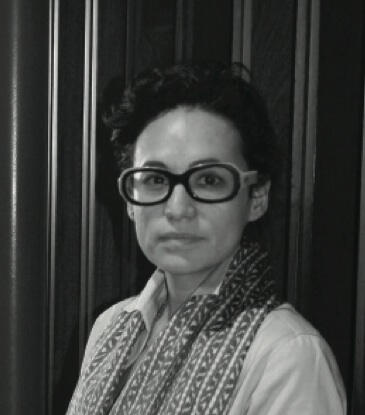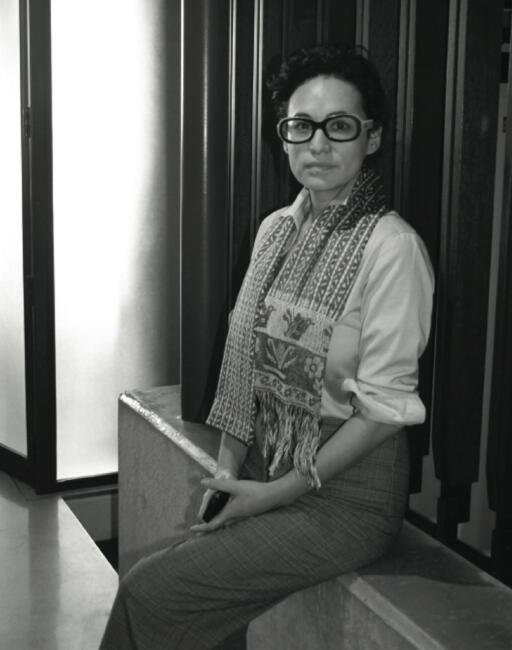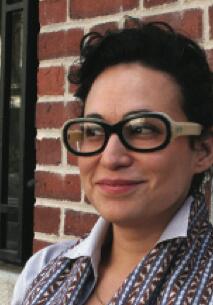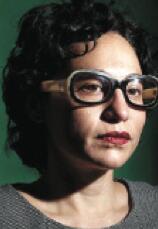Sofía Hernández Chong Cuy
Contemporaneity and its Production Contexts under Sofía Hernández Chong Cuy’s Microscope
This Mexican curator must rethink the future of one of the finest private collections of Latin American art in the world. While she studies the references from the past that may be found in the current artistic production and learns about new practices in gestation, she defines her work as the new curator of contemporary art and imagines how the Patricia Phelps de Cisneros Collection may grow in a way that benefits artists while reaching a new audience.

The streets of San Diego and Tijuana were a significant source of knowledge for Sofía Hernández Chong Cuy. When she was still a student, the current curator of contemporary art for the Patricia Phelps de Cisneros Collection (CPPC) changed the classrooms of the University of Monterrey for an internship in the binational project InSite, a live laboratory established in 1991 on the Mexican-American border, which created new scenarios for visual artists from the “Americas.”
Her car, in which she drove artists from one place to another, became a formative space. As it traveled long distances between cities, the vehicle was a mobile school where long gatherings allowed her to obtain an in-depth knowledge of artistic creation and production.
The 1990s, which marked the beginning of Chong Cuy’s career, were a relevant period for contemporary art in Mexico, as the thirty-five-year-old curator recalls. The creation of new museums in cities other than the capital, such as the Museum of Contemporary Art in Monterrey, and initiatives such as InSite in Tijuana/San Diego, permitted a new approach to the work of artists and the emergence of more exhibition and production spaces.
Born in Mexicali, Baja California, Hernández Chong-Cuy forged the bases of her career in Art Management under the influence of the young cities in Northern Mexico. In Monterrey, she was a member of a very active community which, she assures, “currently has a prominent participation in the visual arts,” and which included artists such as Irene Clouthier and Mario García Torres, the founder of the art fair Zona MACO – Zélica García – and the editor of Celeste magazine, Vanessa Fernández, who had been her teacher. However, that period of bustling about between the border cities of Tijuana and San Diego, during which she produced her thesis based on the binational administrative model proposed by InSite, was vital to define her future in the art scene. A Master’s Degree in Curatorial Studies from Bard College brought her to the state of New York, and later to the city of the same name, which has offered her all sorts of opportunities to forge a reputation for herself in the field of contemporary art. After working at the Americas Society and Art in General, her current mission is that of rethinking the future of one of the most select private collections of Latin American art in the world.
CL: What attracted your attention in a project like InSite?
SHC: InSite had a very innovative administrative structure derived from its binational character. In 1997, the curatorial project was focused on public art by artists from the Americas. The exhibition gathered together artists who had never been included in a group show, and who participated in a three-year art residency.
CL: What did you learn from that experience?
SHC: That experience allowed me to become familiar with the many sides of artistic production. The importance of logistics, which is necessary to culminate a project, but also the importance of wasting time, of walking aimlessly, spaces and moments that become creative.
CL: What artists did you meet during that period?
SHC: I worked in projects by Nari Ward and José Antonio Hernández-Diez, I met a great many artists, including Eduardo Abaroa, Daniela Rossel and Ken Lum. Many of them have been my intellectual mentors. With Lum, in particular, I had a very long epistolary relationship.
New York: Work production
CL: How did you get to work at the Americas Society?
SHC: After I graduated from Bard College, Gabriel Pérez- Barreiro hired me at the Americas Society (AS). I worked there for three and a half years as an exhibitions coordinator, and later as an associate curator.
CL: Which AS program left a stronger imprint on your career?
SHC: I had the fortune of working in AS a Satellite, a mapping of independent programs in which the Americas Society became a presentation space for those independent initiatives. The program included alternative spaces, artists collectives and editorial projects, which developed on the basis of each country’s political culture, as for example, Rés do Chãu (Brazil), La Panadería (Mexico), Instant Coffee (Canada) and Muro Sur (Chile).
CL: What was it like to organize the first Allora & Calzadilla exhibition in New York (Puerto Rican Light: Allora & Calzadilla, 2003), which you also featured for AS?
SHC: Actually, it was incredible. It took us two years of work to finally present the exhibition at the Americas Society. There were many ideas, and I finally opted for an exhibition featuring new and existing works, and relying on a constant conversation with the artists. This experience did not only help me learn more about work production; we also conceived an educational project that was taken to three schools and that implied a strong personal involvement with the community. The project undoubtedly had wide repercussions for the artists.
CL: How did you become involved with Art in General, the non-profit organization created in 1981 by artists Martin Weinstein and Teresa Liszka? SHC: My transition to Art in General originated in my experience with independent initiatives such as AS a Satellite, and in my work with emerging artists (at that time, Allora & Calzadilla were emerging artists). Holly Block, currently the director of the Bronx Museum, was the person who invited me to join Art in General. Our idea at Art in General was to reflect on the reasons to host open calls in art in order to present group shows, and on the relationship of these calls with the democratic discourse. That system functioned in Art in General during the first two decades of the program, because there wasn’t such a wide market for exhibitions as the one that currently exists. So we decided to change the program in order to assist artists with the development of new projects through a program focused on commissioning new artworks.
CL: The idea was to create a system that would constitute an alternative to that dominant cultural structure?
SHC: What we wanted was to support artists in a more significant way than by just offering a space for a thematic exhibition. The idea was to support artists in the longer term, through the creation of another system, more permeable to the introduction of new voices.
CPPC: The contemporary, and new settings
CL: Can we continue talking about contemporaneity as we did before?
SHC: In my opinion, when reference is made to the contemporary, this does not exactly imply present-day art; it has more to do with practices, ways of working, of seeing and analyzing. The attempt to define the contemporary must take into account that which has been done throughout the 20th century, which is important as a reference point for present-day art, and that which is currently in the process of gestation and has not yet materialized or become evident.
CL: If this were the case, what questions should be answered in this new position?
SHC: One of the subjects on which I have invested more time recently is how to define the curatorship of contemporary art in relation to, let’s say, the curatorship of modern art. The very title assigned to my position insists upon the existence of “the contemporary”, at least as a taxonomy for art. I think the challenge resides in interrogating dates and styles, as well as common languages, the artificiality of documents, and islands of thought.
CL: What is the first step you must take as contemporary art curator for the CPPC?
SHC: The position exists, but the profile and functions implied are not fully defined. Now the task that lies ahead is not only to define lines of work, but also to determine in what way a contemporary art curator can be useful in the case of this collection. I am in the process of becoming acquainted with the collection’s assets and imagining in what way it can grow, and in what way this may be a significant process for artists and audiences.
CL: What have the findings been in this initial diagnosis phase?
SHC: I have found that in the Collection, “modern art” is well defined and articulated. Hence, is the contemporary represented by art spanning the period from the advent of conceptualism to the present, or by art from the beginning of the 21st century to the present? I also think it is interesting to consider the institutional tendencies that this situation is giving rise to. What will the recently created museums of contemporary art be in fifty years time? Unlike Modernism, the contemporary has not yet forged a philosophy, an ideology, or a political project that may have an impact through reforms or urban design, for instance. There is much to be defined with respect to contemporaneity and how it is read in its production contexts.
CL: What immediate opportunities do you envision to strengthen ties between your institution and other organizations with the aim of promoting Latin American art?
SHC: The CPPC supports other existing structures in order that they may include the history of modern Latin American art and contemporary artists in their study programs and their art residencies.These are very important inclusion efforts. I would like to participate in the introduction − and also share the experience − of other contexts beyond the Americas. I would like to begin to create opportunities in Continental and Eastern Europe, as well as in Africa and the Middle East.
Profile:
Sofía Hernández Chong Cuy is the curator of contemporary art at the Patricia Phelps de Cisneros Collection. She is also the author of the Sideshows.org blog, as well as of multiple catalogues and articles for specialized art publications. Having pursued art studies at the University of Monterrey, she graduated from the Center for Curatorial Studies at Bard College. She also works as an agent for Documenta 13, and since 2009, she has been a board member of Kunstverein in Amsterdam. In 2009-2010, she was the director of the Tamayo Museum, in Mexico FD. She has organized exhibitions such as Autopsia de lo invisible (MALBA, Argentina) and Archaeology of Longing (Kadist Art Foundation, France), and has been an associate curator and programs director at the Americas Society, Art in General, and the 9th Baltic Triennial “Black Market Worlds” (Lithuania).





